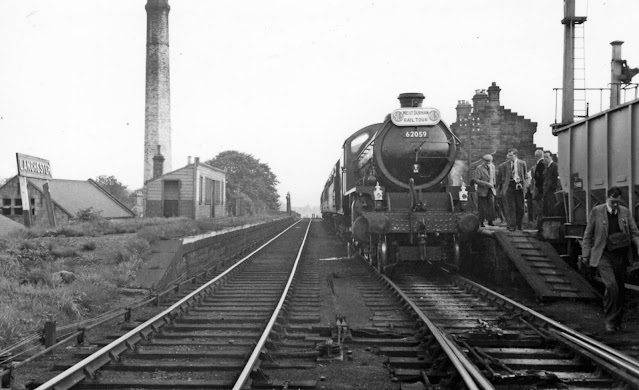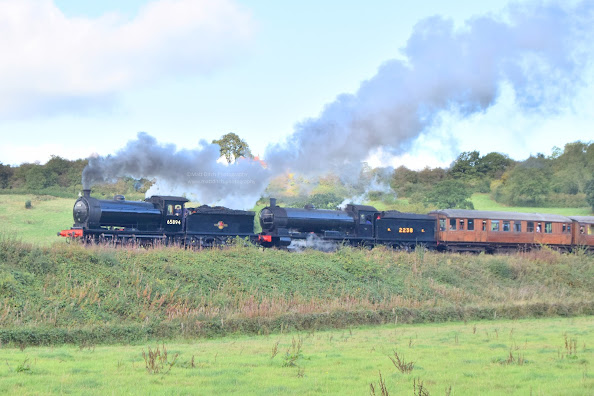The Lanchester Valley Railway
The Lanchester Valley Railway
View SE towards Durham, on the then freight-only (since 2/5/39) Durham - Blackhill ex-NER line, which remained for freight until 5/7/65. The SLS West Durham Rail Tour is head by Thompson-design K1 2-6-0 No. 62059 (built 12/59, withdrawn 2/67 - a short life). Walter Dendy - Creative Commons Attribution Share-alike license 2.0
The Lanchester Valley Railway was once part of County Durham's extensive railway network. It was opened in 1862 by the North Eastern Railway. With construction starting a year earlier. It linked Durham with the town of Consett. One of the main purposes of the railway was to link the Ironworks at Consett with the Iron ore mines of Cleveland and Middlesbrough, when the line closed this traffic was transferred to the nearby “Stanhope & Tyne railway”.
View NW, towards Blackill; Lanchester Valley line (Durham - Blackhill). Called Aldin Grange until 1/5/27, this station was closed entirely on 1/5/39 when the passenger service ceased, but goods continued and the line was not closed until 20/6/66. Ben Brooksbank - Creative Commons Attribution Share-alike license 2.0The first station out of Durham was Bearpark or Aldin Grange (pictured above) It was opened in 1883 and renamed Bearpark in 1927. This station was located next to Bearpark Colliery. A number of coal mines were built along the length of the railway, this was due to an 1870 survey by Lord Lambton who owned land in the valley successfully found coal. The station closed in 1939 when passenger services along the line were withdrawn. Today there are no remains of the station.
The next station on the line was Witton Gilbert. This station was one of the original stations on the line and opened in 1862. It sits near the village of Langley park, where there was also another colliery (Langley Park Colliery).
As the above images show the station building and part of the platform survive here. The station is now a private residence, which is probably why a tall hedge has been grown along the edge of the platform! The station building has been built to the typical North Eastern Railway design. There are 2 others to the same design still standing along the line.
From here the line climbed past the site of Langley Park Colliery, now Diggerland on its way towards Lanchester.
Shortly after leaving Malton Picnic area the railway passes under the access road for the local sewage works. Since closure of the line the bridge has been strengthened with the addition of two extra supports.
The double track over bridge on approach to Lanchester Station. There was another overbridge which spanned Station road/B6296, but that has now been removed. Lanchester station, Like the others it closed in 1939, but saw occasional use after for railtours and Durham miners gala trains. The station had a sizable goods yard located behind the main building, which included a large goods shed and saw mill.
Today the station building survives as a luxury holiday let and still retains it’s platform, although no trains have called here in a long time! There was another platform on the opposite side where the trees stand today. The above picture was taken looking back in the direction of Durham, you can see the almost immediate drop away from the edge of the station where the bridge over Station road From here the railway begins it’s climb out of Lanchester and towards the site of Lanchester Colliery and Knitsley Viaduct.
After a steady climb away from Lanchester we reached the site of the colliery. Today the site has been returned to agricultural use so there was little to see of the actual colliery, but what we did find was the bricked up remains of the signal box (left) that controlled the tracks here.
On approach to the site of Knitsley Viaduct (below).
The site of the viaduct today (in the trees!). Compare my above shot with this image. Which shows the viaduct at the start of the work to fill it in. A siding was built down from the railway for works trains to transport waste materials to fill it in with. This shot shows the bridge almost completely buried. It would be interesting to know if any of the orignal structure survives under all that muck.
The peace and quiet of the countryside was briefly disturbed here when a pair of Apache helicopters flew overhead. From the viaduct the course of the railway is briefly lost under farmland which reclaimed it after the railway shut. The railway can be traced again near to the site of Knitsley Station. The station buildings and platforms both still remain in place as the below image shows.
From here the railway carried on towards Consett. On the outskirts of the town the railway passed Lydgetts Junction. This was the junction between the Stanhope & Tyne, Lanchester Valley and Lanchester Railway Extension to Newcastle. Consett Iron works lay just beyond the junction but has today been redeveloped as housing.
At Lydgetts Junction, near to where the Lanchester Valley Line passed under. This “Slag Wagon” has been placed on a short section of track as a monument to the Consett Iron Works History.
If you’ve enjoyed this then please consider supporting this website so that I can continue to deliver new content like this. Patreon and Ko-Fi



















I can confirm that William Weaver Tomlinson wrote The North Eastern Railway, its Rise and Development. I have a signed copy!
ReplyDelete